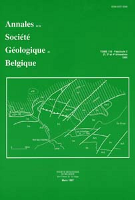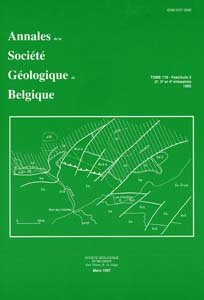- Accueil
- Volume 117 (1994)
- Fascicule 1 - Stratigraphie du Paléozoïque : Homma...
- The stratigraphical position of the oldest known Pterygota (insecta. Carboniferous, Namurian)
Visualisation(s): 614 (5 ULiège)
Téléchargement(s): 1175 (4 ULiège)
The stratigraphical position of the oldest known Pterygota (insecta. Carboniferous, Namurian)

Résumé
La position stratigraphique des plus anciens Ptérygotes connus (insectes; Carbonifère, Namurien). La position stratigraphique de quelques insectes ptérygotes du Namurien est revue. La plus ancienne espèce connue est Delitzschala bitterfeldensis C. Brauckmann & Schneider (1995); elle provient du Namurien A inférieur (Arnsbergien, E2) de la région de Bitterfeld/Delitzsch (Allemagne). En raison de la nouvelle définition adoptée pour la limite Mi-Carbonifère, cette séquence appartient maintenant à la partie d'âge carbonifère inférieur du Namurien. Pour autant que l'on puisse le déduire des travaux antérieurs, les autres ptérygotes namuriens proviennent de la partie d'âge carbonifère supérieur. Ampeliptera limburgica Pruvost, 1927 du bassin houiller du sud du Limbourg (Pays-Bas) est très probablement d'âge Namurien A supérieur (Alportien). Deux espèces pourraient être attribuées aux strates du Namurien B inférieur (Kinderscoutien): Stygne roemeri Handlirsch, 1906 (Pologne) et Brodioptera stricklani Nelson & Tidwell, 1988 (Utah, USA). Toutes les autres espèces du Namurien sont plus récentes (Marsdenien à Yeadonien). L'âge namurien inférieur attribué antérieurement à Eugeropteron lunatum Riek, 1984 et Geropteron arcuatum Riek, 1984 (Malanzân, Argentine), ainsi qu'à Xenoptera riojaensis Pinto, 1986 de la même localité n'est pas certain; un âge westphalien ancien semble plus probable pour ces trois espèces.
Abstract
The stratigraphical position of some Namurian pterygote insects is reviewed. The oldest hitherto known species is Delitzschala bitterfeldensis C. Brauckmann & Schneider, 1995 (in press) from Lower Namurian A (Arnsbergian, E2) strata of the Bitterfeld/Delitzsch area, Germany. Due to the new definition of the Mid-Carboniferous boundary, this sequence now belongs to the Lower Carboniferous part of the Namurian. The other Namurian pterygotes come from the Upper Carboniferous part. Ampeliptera limburgica Pruvost, 1927 from the South Limburg coal-field (the Netherlands) is most probably of Upper Namurian A (Alportian) age. Two species, Stygne roemeri Handlirsch, 1906 from Upper Silesia (Poland) and Brodioptera stricklani Nelson & Tidwell, 1988 from Utah (USA), can tentatively be allocated to Lower Namurian B (Kinderscoutian) strata. All further certain Namurian species are younger (Marsdenian to Yeadonian). The previously supposed Lower Namurian age of Eugeropteron lunatum Riek, 1984 and Geropteron arcuatum Riek, 1984 from Malanzân, Argentina, as well as of Xenoptera riojaensis Pinto, 1986 from the same locality is not certain; an early West-phalian age for these species appears more likely.





